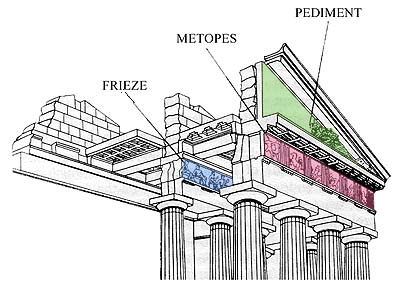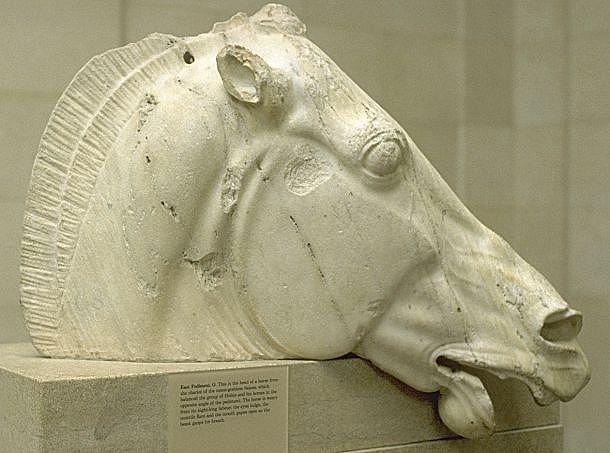
ANTH 3130 Archaeology & Society
Class notes 1 Nov 2007
Welcome back!
Plan for Class today...
Attendance sheet...
Announcements
Parthenon Marbles debate (hand in assignments)
- break -
The Secret History of Ontario... video and discussion.
Hand back outlines.
Homework for Today, 1 November, was this:
Reading for Thurs Nov 1: Holtorf Ch 7-9 AND Rowan Ch 1, 3, 4
Then back to the schedule as originally stated.
Write a 300-400 word discussion of the Parthenon Marbles, based on the readings to date and, if you like, online sources like those below. Why can't the different parties agree? What do you think should be done with them? On what basis do you make your argument?
Worth 3% towards your seminar participation mark.
Please come ready to talk in class.
For last week, you were asked to please come prepared to discuss these questions:
a) Stonehenge comes up a few times in the Holtorf book and the Skeates book. Pay special attention to those references. Consider: what's the best way to understand what Stonehenge means to people today?
b) Authenticity: what does it really mean to you? Does it matter whether something is real or a replica? Why or why not? Think about concrete examples from your own world.
c) Is the past a renewable resource? What do you think? What do Holtorf and Skeates each think?
WE'LL RETURN TO THOSE QUESTIONS NEXT WEEK, AS PART OF THE DISCUSSION ABOUT HERITAGE TOURISM.
WHAT LIES AHEAD
Week of Nov 8: Rowan & Baram Ch 5, 6, 7. For class, be ready to compare the different examples of heritage tourism in Rowan & Baram Ch 5, 6, 7 and relate to any experiences you've had with historical sites. Also be prepared to comment on Holtorf's arguments about authenticity and renewability etc.
Week of Nov 15: PAPER IS DUE IN CLASS. ALSO THIS READING: Rowan & Baram Ch 11, 14, 16, 17. As you read, think about why, and by whom, some landmarks are restored, destroyed, replicated, and sold.
For Nov 22: No reading. Poster Party Day!
Parthenon Marbles
- aka Elgin marbles (hard 'g') after the English lord who had them removed from Greece
- sculptures from the building called the Parthenon in the ancient city centre (Acropolis) of Athens





http://www.davidgill.co.uk/attica/parthenon/frieze.htm
- pediment sculptures - in the round - lots in the UK
- metopes (metuhpees)
- frieze - in low relief (mostly still in Athens)

Pediment sculpture
What the effect was probably like in antiquity - painted, gold leaf


Erechtheion with Caryatid Porch - many also in BM

The Parthenon Marbles:
http://www.uk.digiserve.com/mentor/marbles/ Particularly look at "What are the Parthenon Marbles", "The History of the Marbles", and "Neal Ascherson on the Parthenon Marbles".
Parthenon..... http://www.thebritishmuseum.ac.uk/gr/debate.html
Parthenon Marbles

Image from Hellenic Ministry of Culture
www.museum-security.org/The%20Parthenon%20Marbles.htm
The British Museum says:
“The British Museum holds in trust for the nation and the world a collection of art and antiquities. The Parthenon sculptures … are displayed in purpose-built galleries seen every year by some six million visitors, free of charge. The Museum is committed to … communicating to a world audience and providing an international context where cultures can be experienced by all... The sculptures from the Parthenon have come to act as a focus for Western European culture and civilisation, and have found a home in a museum that grew out of the eighteenth-century 'Enlightenment', whereby culture is seen to transcend national boundaries.
The Museum is always developing new ways of promoting the understanding of the sculptures by the widest possible audience.” From The 'Elgin Marbles': Ownership, on the British Museum’s Compass website.
SO Homework Questions for Today Were These:
Why can't the different parties agree?
What do you think should be done with them?
On what basis do you make your argument?
British Museum holdings
http://www.thebritishmuseum.ac.uk/compass/ixbin/goto?id=OBJ5786
Statement: http://www.thebritishmuseum.ac.uk/gr/grparth.html
But some are also held in other major museums e.g. Louvre, Getty
News: Parthenon Fragment Returned to Greece
http://www.theartnewspaper.com/article01.asp?id=185
Digital options:
http://gl.ict.usc.edu/parthenongallery/S2003_parth_sketch_5_files/frame.htm
http://gl.ict.usc.edu/parthenongallery/renders/index.html
Marbles Reunited
http://www.marblesreunited.org.uk/
The New Acropolis Museum in Athens

National Film Board of Canada ; directed by Jennifer Holness, David Sutherland ; producer, Peter Starr. Publication info: [Montréal] : NFB, 2000. YORK Video #5913.
Abstract: The Old Durham Road Pioneer Cemetery in Priceville, Ontario, burial ground of the area's original black settlers, lay for many years hidden under a farmer's potato field. In the 1980's, descendants, both black and white, begin to restore the cemetery. As the work progresses, new evidence, resident's memories, and a decision to dig in the cemetery to search for grave stones, divide the community. Now everyone must come to terms with this hidden history.
"Speakers for the Dead
examines a small town in rural Ontario and its quest to restore the history and
dignity of its Black descendants.
This story begins in the 1820s when ex-slaves and Black Loyalists, veterans of
the War of 1812, settled in Priceville, southwest of Collingwood, Ontario. The
area's first non-native settlers, they established homesteads, a school and a
cemetery. Around the time of confederation (1860s), Scottish and Irish settlers
displaced them, pushing them off the land to Owen Sound, Collingwood and further
south. Soon, the only remnant of their existence in Priceville was the cemetery.
Fast forward to the 1930s, when a Priceville farmer tears up their tombstones to
plant potatoes and buries some of the grave markers under a two-ton pile of
stones.
Speakers for the Dead traces the journey of discovery begun in the 1980s
by descendants of Priceville's Black and White settlers. Could they find other
tombstones? Would their search lead to a greater understanding of their origins?
As they delve into the story of Blacks in the Priceville area, new truths are
revealed and the townspeople are divided."
"The dead are not quiet in Priceville.
They have come forward from a forgotten corner of a farmer's field to tell an extraordinary tale. But not everyone is ready to listen.
Filmmakers Jen Holness and David Sutherland travel to the farm country south of Georgian Bay to retrieve the lost history of the first non-Native settlers in the area - and to document the far-reaching repercussions of the full story coming to light.
"At school we rarely had the sense that Black people were part of this country's past," says Holness. "In fact Blacks have a long and interesting history in Canada - but it is often overlooked in the official texts."
The story begins in the 1820s when ex-slaves and Black Loyalists, veterans of the War of 1812, establish a farming community in the area. They are later displaced by white settlers - Scottish and Irish immigrants who arrive around the time of confederation.
For decades, the only sign of the original settlement is a graveyard, but in the 1930s this too disappears when a local farmer tears up the tombstones to plant potatoes. The stones are scattered - and the history of the original settlers slips into oblivion.
Fast forward to the 1980s, when a few determined residents join forces with descendants of the settlers to form a restoration committee. They succeed in finding various fragmented remnants of the burial site, eventually winning recognition for the Old Durham Road Pioneer Cemetery.
But plans for an archaeological dig meet with deep ambivalence. Not everyone in Priceville is ready to confront what further research might reveal about their town's past.
"Official history is usually written by the victors, by the dominant forces in society," says Holness. "With Speakers of the Dead, we hope to ensure that school kids in Grey County - and across Canada - get a more complete picture of our rich and multi-layered history."
Juxtaposing interviews with evocative re-enactments, Holness and Sutherland provide a gripping account of Priceville's past and a fascinating lesson on the nature of history itself."
http://www.cbc.ca/roughcuts/feature_061101.html
FOR YOU TO THINK ABOUT AS YOU WATCH:
Did you know about this aspect of Ontario’s history? Why or why not? How does this make you feel?
Is the truth about Ontario’s history important? Why or why not? To whom?
How does this compare to other places where racism has played a role in official or ‘common-knowledge’ versions of history?
Can you see the steps involved in the suppression of real history? How hard is it to destroy monuments? How does the destruction of monuments affect community memory? What are the motivations people have for acting this way?
How does the treatment of the dead affect the living?